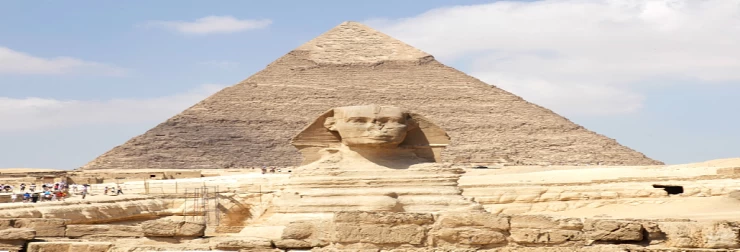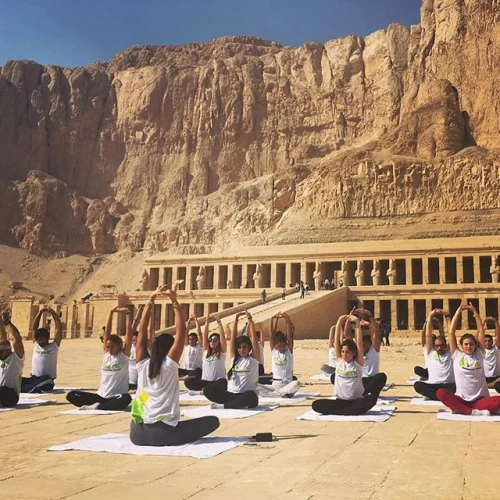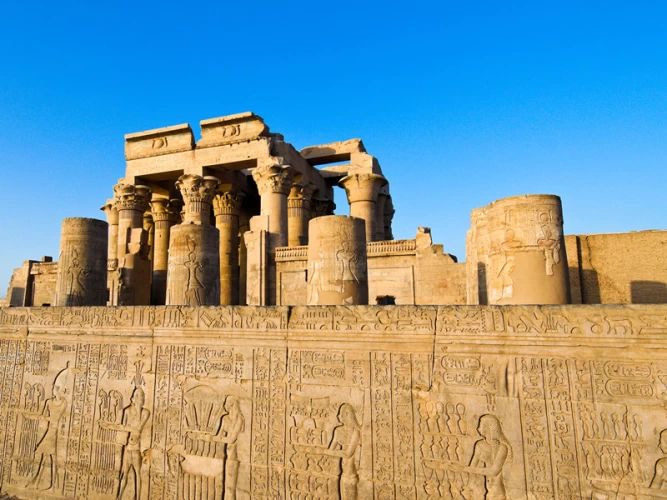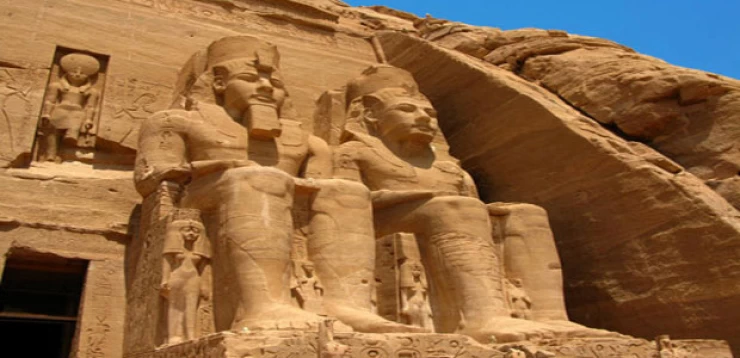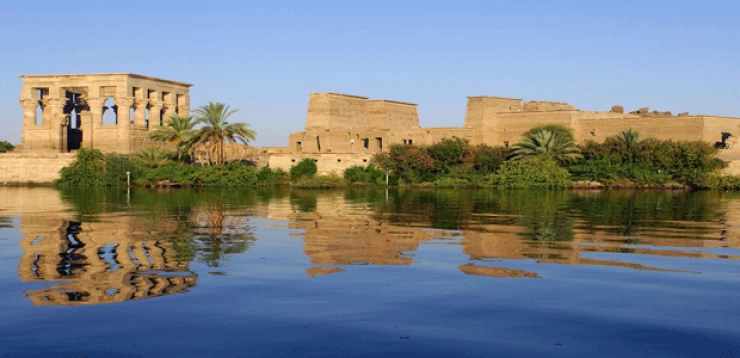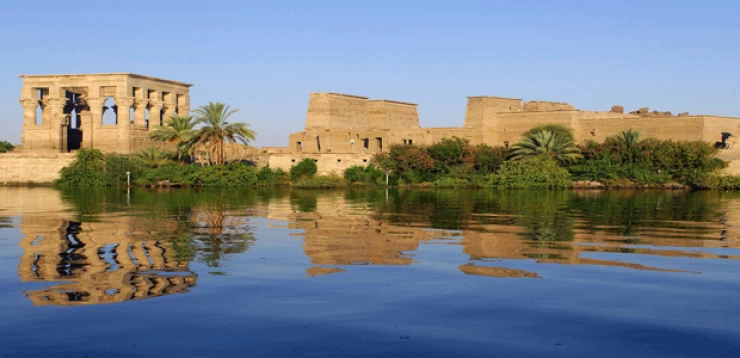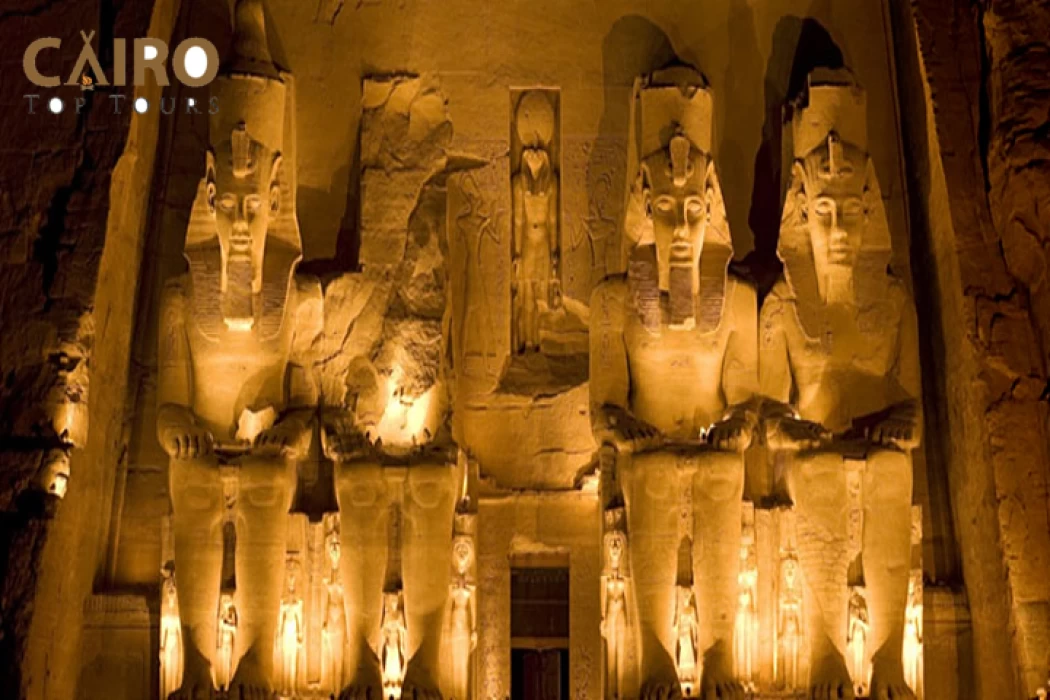
Abu Simbel Temples | Temple of Ramses II
Following the death of Pharaoh Ramses II, the Abu Simbel temple was constructed as a site of veneration for him and as a demonstration of authority over the newly acquired Nubian region. The temple is most renowned for its four massive statues of Ramses II that stand at its entrance.
The facade, rising to a height of 33 meters, features the four grand statues of Ramses II adorned with the double crown representing Upper and Lower Egypt. This architectural marvel served to convey the pharaoh's dominance to visitors arriving from the south during the New Kingdom, specifically in the 19th dynasty.
The history of the Abu Simbel Temple reveals that this magnificent structure was dedicated to the protective deities of ancient Egypt, namely Amun of Thebes (present-day Luxor), Ptah of Memphis (the capital during the Old Kingdom), and Ra. Additionally, it honors Harakhty of Heliopolis. This temple, intricately carved into the rocky cliff on the western bank of the Nile, commenced construction in the fifth year of the Pharaoh's reign and was completed over a span of thirty years.
The Abu Simbel Temple In the early era of the illustrious pharaohs of ancient Egypt, this remarkable monument fell into neglect and was gradually engulfed by sand, ultimately vanishing from historical records and receiving no further mention from the Greeks or Romans. It was not until 1813 that Swiss explorer Lewis Burkhardt brought attention to the site, describing it as a collection of statues, with only the heads and shoulders visible. In 1817, Italian explorer Giovanni Battista Belzoni succeeded in entering the temple, though he was disheartened by the limited artifacts found within. For several more decades, the monument remained partially buried until it was fully uncovered in 1909, revealing its grandeur.
The Abu Simbel Temple, the smaller of the two temples in the region, is dedicated to Hathor, the goddess of love. Constructed by Ramses II in tribute to his cherished wife, Nefertari, the temple's façade features six monumental statues, each approximately 10 meters tall, representing Ramses II alongside the queen. These grand figures are accompanied by smaller representations of other royal family members. Inside, the temple boasts a hypostyle hall adorned with pillars crowned with Hathor's heads, alongside depictions of Ramses engaged in the historic battle of Kadesh. The walls are richly illustrated with scenes of Nefertari, Hathor, and Mut, culminating in a portrayal of the royal couple presenting offerings to the deities on the back wall. In the 1960s, the temples of Abu Simbel were meticulously relocated to avoid submersion due to the rising waters of Lake Nasser. This significant endeavor was overseen by UNESCO, which facilitated the transportation and elevation of the monuments to an artificial hill situated 210 meters away and 65 meters higher than their original location. The Abu Simbel temples are essential destinations for travelers on Nile River Cruises in Egypt and are featured in numerous Egypt Day Tours, Travel Packages, Aswan excursions, and Luxor trips. Amun, revered as the ancient Egyptian god of the sun and air, is also known by names such as Amun, Amen, or Amun-Ra. He held a prominent position among the deities of ancient Egypt, particularly in Thebes during the early New Kingdom period (circa 1570-1069 BC). Our knowledgeable guide, an expert in Egyptology from Cairo Top Tours, will accompany you throughout your journey, addressing all your inquiries. With exceptional services provided upon your arrival, our company stands out as the premier choice for exploring Egypt.
Latest Articles
Admin
Aswan Governerate in Egypt
One of Egypt's southern governorates is Aswan Governorate. The city of Aswan serves as its capital. At a latitude of 22 north of the equator (also known as the Tropic of Cancer), it is bounded to the north by the Qena Governorate, to the east by the Red Sea Governorate, to the west by the New Valley Governorate, and to the south by the Republic of Sudan.
Admin
Luxor Governorate Egypt
The capital of the Arab Republic of Egypt is Luxor City, which was once known as "Thebes City" because it served as Egypt's capital during the Pharaonic era. It is situated in the South Upper Egypt region, approximately 670 kilometers from the capital Cairo from the south. It is bordered on the north by Qena Governorate, on the south by Aswan Governorate, on the east by Red Sea Governorate, and on the west by New Valley Governorate.
Admin
History of kafr El Sheikh Governorate
Kafr El Sheikh Governorate is an Egyptian governorate, located in the northernmost part of Egypt in the Nile Delta, with Kafr El Sheikh as its capital. It had a population of 3,172,753 in 2015 and an area of 3,748 km². Its entire area is located north of the delta and overlooks the Mediterranean Sea. The main economic activity of the residents of the governorate is agriculture and fishing, especially the southern lands of the governorate and the lands overlooking the Nile River - Rosetta Branch.
Admin
Egypt's New Administrative Capital
The New Administrative Capital is located between the Cairo-Suez and Cairo-Ain Sokhna roads, 60 km from Cairo and the same distance from Ain Sokhna and Suez. The New Administrative Capital is located on the border of Badr City, in the area between the Cairo-Suez and Cairo-Ain Sokhna roads, just after New Cairo, Mostakbal City and Madinaty.
Admin
Al Gharbia Governorate
Gharbia Governorate is one of the governorates full of archaeological sites, whether they are places or facilities (mosques, churches), as the governorate is a destination for visitors to these places throughout the year, whether they are Egyptians from the different governorates.
Admin
Hamata Islands (Qulaan Archipelago) in Marsa Alam
The Hamata area, south of Marsa Alam in the Red Sea, is one of the most important parts of the Wadi El Gemal Reserve, whether in the desert or the sea. It was named after the sorrel plant, which was distorted to Hamata.






